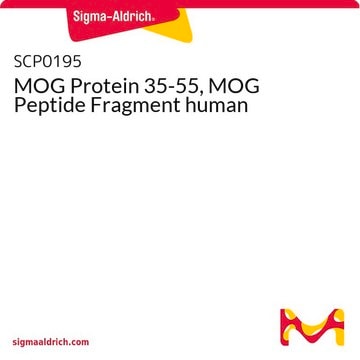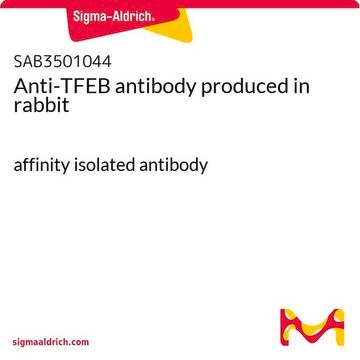推荐产品
生物源
mouse
品質等級
共軛
unconjugated
抗體表格
ascites fluid
抗體產品種類
primary antibodies
無性繁殖
AA6, monoclonal
包含
15 mM sodium azide
物種活性
human, feline, bovine, hamster, chicken, mouse, rat
技術
microarray: suitable
western blot: 1:500 using a fresh total rat brain extract or an enriched microtubule protein preparation
同型
IgG1
UniProt登錄號
運輸包裝
dry ice
儲存溫度
−20°C
目標翻譯後修改
unmodified
基因資訊
human ... MAP1B(4131)
mouse ... Mtap1b(17755)
rat ... Map1b(29456)
一般說明
MAP1b is a microtubule associated protein that interacts with actin filaments. MAP1b regulates microtubule stabilization and the development of axons. It may also act as a scaffolding protein Addition of antibody to microtubule proteins before polymerization in immunoassays results in abnormally short (but otherwise morphologically normal) microtubules. Immunohistochemical staining of brain tissue with the product shows selective labeling of dendritic trees throughout the brain. Monoclonal Anti-MAP1b does not react with tubulin of other microtubule associated proteins.
Monoclonal Anti-MAP1b (MAP5) (mouse IgG1 isotype) is derived from the hybridoma produced by the fusion of mouse myeloma cells and splenocytes from an immunized mouse. Microtubule-associated protein (MAP1B) is the major microtubule associated protein in developing brain which changes its expression during development. In the new born rat brain, it is a major component of microtubules but in the adult its level is ten-fold lower.
特異性
Monoclonal Anti-MAP1b antibody is specific for MAP1b in humans, mice, rats, bovines, cats, hamsters and chickens. The antibody does not cross-react with other MAPs or tubulin. Addition of the antibody to microtubule proteins before polymerization results in abnormally short (but otherwise morphologically normal) microtubules. In immunohistochemical staining of brain tissue, the antibody shows selective labeling of neurons with stronger staining of axons, dendrites and cell bodies.
免疫原
rat brain microtubule-associated proteins (MAPs)
應用
Monoclonal Anti-MAP1b antibody produced in mouse has been used in:
- immunohistochemistry
- immunostaining
- fluorescence microscopy
生化/生理作用
Microtubule-associated protein (MAP1B) is the first MAP to appear in growing axons during development as it is present from the first emergence of the nascent axon from the cell body. Monoclonal Anti-MAP1b may be used to study MAP expression and cytological localization both in tissues and cell lines, under different developmental and environmental circumstances.
免責聲明
Unless otherwise stated in our catalog or other company documentation accompanying the product(s), our products are intended for research use only and are not to be used for any other purpose, which includes but is not limited to, unauthorized commercial uses, in vitro diagnostic uses, ex vivo or in vivo therapeutic uses or any type of consumption or application to humans or animals.
Not finding the right product?
Try our 产品选型工具.
儲存類別代碼
10 - Combustible liquids
水污染物質分類(WGK)
WGK 2
閃點(°F)
Not applicable
閃點(°C)
Not applicable
Human mesenchymal precursor cells (Stro-1+) from spinal cord injury patients improve functional recovery and tissue sparing in an acute spinal cord injury rat model
Hodgetts SI, et al.
Cell Transplantation, 22(3), 393-412 (2013)
Association of microtubule-associated protein (MAP1B) with growing axons in cultured hippocampal neurons
Fischer I and Romano CG
Molecular and Cellular Neurosciences, 2(1), 39-51 (1991)
Masamitsu Shimazawa et al.
The Journal of pharmacology and experimental therapeutics, 332(2), 380-387 (2009-11-17)
We examined whether ((1S)-1-((((1S)-1-benzyl-3-cyclopropylamino-2,3-di-oxopropyl)amino)carbonyl)-3-methylbutyl)carbamic acid 5-methoxy-3-oxapentyl ester (SNJ-1945), a new orally available calpain inhibitor, might reduce retinal cell death in vivo and/or in vitro. Retinal cell damage was induced in vivo in mice by intravitreal injection of N-methyl-d-aspartate (NMDA), and
Human pluripotent stem cells and derived neuroprogenitors display differential degrees of susceptibility to BH3 mimetics ABT-263, WEHI-539 and ABT-199
Garcia CP, et al.
Testing, 11(3), e0152607-e0152607 (2016)
Carolina Paola García et al.
PloS one, 11(3), e0152607-e0152607 (2016-04-01)
Human embryonic stem cells (hESCs) are hypersensitive to genotoxic stress and display lower survival ability relative to their differentiated progeny. Herein, we attempted to investigate the source of this difference by comparing the DNA damage responses triggered by the topoisomerase
我们的科学家团队拥有各种研究领域经验,包括生命科学、材料科学、化学合成、色谱、分析及许多其他领域.
联系技术服务部门








